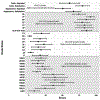Long-term functional and esthetic outcomes after fibula free flap reconstruction of the mandible
- PMID: 30761650
- PMCID: PMC6579701
- DOI: 10.1002/hed.25666
Long-term functional and esthetic outcomes after fibula free flap reconstruction of the mandible
Abstract
Background: The goal of this study is to report functional and esthetic outcomes, after fibula free flap (FFF) reconstruction of the mandible for oral cancer, assessed by physicians, nonclinicians, and patients.
Methods: Twenty-five long-term survivors from oral cancer after FFF reconstruction were recalled for head and neck examination by surgeons, for photographs and patient-reported outcomes, using EORTC, QLQ-C30, H&N35, and FACE-Q questionnaires.
Results: Physicians reported 64% restoration of functionality compared to normal. Patients reported high scores on QLQ-C30 but lower scores on H&N35. Esthetic scores were reported higher by clinicians than nonclinicians. The decline in function and appearance was attributed to loss of lower dentition, trismus, malocclusion, xerostomia, and tissue atrophy.
Conclusion: To minimize the decline in function and appearance, immediate dental implants in FFF, better reconstruction of the temporomandibular joint, newer methods of radiotherapy to minimize xerostomia and oral exercises to prevent trismus should be considered.
Keywords: FACE-Q; QLQ C30; QLQ HN-35; esthetic outcomes; fibula free flap; functional outcomes; head and neck cancer; long-term survivors; malocclusion; oral cancer; patient-reported outcomes; quality of life; trismus; xerostomia.
© 2019 Wiley Periodicals, Inc.
Conflict of interest statement
CONFLICT OF INTEREST STATEMENT: None declared.
Figures






Similar articles
-
Long-Term Follow-Up of Computer-Assisted Microvascular Mandibular Reconstruction: A Retrospective Study.J Clin Med. 2024 Jul 3;13(13):3899. doi: 10.3390/jcm13133899. J Clin Med. 2024. PMID: 38999465 Free PMC article.
-
A systematic review of validated tools assessing functional and aesthetic outcomes following fibula free flap reconstruction of the mandible.Head Neck. 2019 Jan;41(1):248-255. doi: 10.1002/hed.25452. Epub 2018 Dec 12. Head Neck. 2019. PMID: 30548509 Free PMC article.
-
Health-related quality of life after segmental resection of the lateral mandible: Free fibula flap versus plate reconstruction.J Craniomaxillofac Surg. 2015 Jun;43(5):658-62. doi: 10.1016/j.jcms.2015.03.018. Epub 2015 Apr 2. J Craniomaxillofac Surg. 2015. PMID: 25939312
-
Quality of Life after Free Fibula Flap Reconstruction of Segmental Mandibular Defects.J Reconstr Microsurg. 2018 Feb;34(2):108-120. doi: 10.1055/s-0037-1606537. Epub 2017 Sep 13. J Reconstr Microsurg. 2018. PMID: 28905342
-
Quality of life issues in cancer of the oral cavity.J Laryngol Otol. 2002 Oct;116(10):785-90. doi: 10.1258/00222150260293574. J Laryngol Otol. 2002. PMID: 12437831 Review.
Cited by
-
Prognostic factors associated with achieving total oral diet following osteocutaneous microvascular free tissue transfer reconstruction of the oral cavity.Oral Oncol. 2019 Nov;98:1-7. doi: 10.1016/j.oraloncology.2019.09.006. Epub 2019 Sep 12. Oral Oncol. 2019. PMID: 31521884 Free PMC article.
-
Health-Related Quality of Life in Oral Cancer Patients: Scoping Review and Critical Appraisal of Investigated Determinants.Cancers (Basel). 2021 Aug 31;13(17):4398. doi: 10.3390/cancers13174398. Cancers (Basel). 2021. PMID: 34503208 Free PMC article.
-
Long-Term Follow-Up of Computer-Assisted Microvascular Mandibular Reconstruction: A Retrospective Study.J Clin Med. 2024 Jul 3;13(13):3899. doi: 10.3390/jcm13133899. J Clin Med. 2024. PMID: 38999465 Free PMC article.
-
Masticatory performance in patients undergoing free fibula flap for mandible reconstruction.BMC Oral Health. 2022 Mar 18;22(1):78. doi: 10.1186/s12903-022-02114-4. BMC Oral Health. 2022. PMID: 35300661 Free PMC article.
-
Impact of Periosteal Branches and Septo-Cutaneous Perforators on Free Fibula Flap Outcome: A Retrospective Analysis of Computed Tomography Angiography Scans in Virtual Surgical Planning.Front Oncol. 2022 Jan 19;11:821851. doi: 10.3389/fonc.2021.821851. eCollection 2021. Front Oncol. 2022. PMID: 35127535 Free PMC article.
References
-
- Curtis TA, Cantor R. The forgotten patient in maxillofacial prosthetics. J Prosthet Dent. 1974;31:662–80. - PubMed
-
- de Fries HO. Reconstruction of the mandible: use of combined homologous mandible and autologous bone. Otolaryngol Head Neck Surg. 1981;89:694–97. - PubMed
-
- Testelin S History of microsurgical reconstruction of the mandible. Ann Chir Plast Esthet. 1992;37:241–45. - PubMed
-
- Ivy RH. Bone grafting for restoration of defects of the mandible. Plast Reconstr Surg (1946). 1951;7:333–41. - PubMed
Publication types
MeSH terms
Grants and funding
LinkOut - more resources
Full Text Sources
Medical

